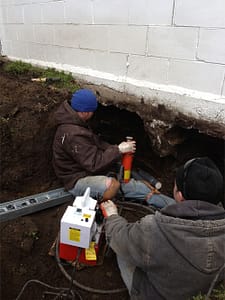The smart Trick of Best Basement Waterproofing That Nobody is Talking About
Table of ContentsThe Best Strategy To Use For Best Basement WaterproofingWhat Does Best Basement Waterproofing Do?The Best Basement Waterproofing StatementsWhat Does Best Basement Waterproofing Mean?Fascination About Best Basement Waterproofing
AdvantaClean's qualified professionals and service technicians will locate the water source. If wall surface or piece splits are present, we will infuse polyurethane and epoxies into the cracks and secure the concession, stopping additional moisture from entering.
If there's condensation outside of the aluminum foil, you have high humidity in your cellar. Fix it with a mobile area dehumidifier or a whole-house humidifier system as opposed to waterproofing products. If the aluminum foil has condensation on the inside surface (next to the wall), the dirt around your house might be naturally damp from a high water table or poor soil drain.
You can waterproof just your interior wall surfaces, which might fix the issue. Once they dry, they adhere completely to concrete and masonry walls.
Best Basement Waterproofing for Beginners
Concrete water-proof finishes can't be applied to formerly repainted surfaces; examine the label. Understood as densifiers, they are suitable only for walls that have not been repainted or sealed.
Yet you comb, roll, or spray it on a lot more heavily one gallon covers just 75 square feet, not the 300 square feet normal with standard paint. Waterproof paint is fine for do it yourself application. You can apply it over painted surfaces, and paint over it once it's healed (one gallon prices $37).
It can set you back $10,000 to $15,000, depending on the work required. Outside waterproofing includes excavating all over your home to the full depth of the structure wall surfaces, then installing a water-proof layer or membrane covered by water drainage panels. The panels supply an easy course for water to move down to an outside French drainpipe at the bottom of your structure.
A cellar without waterproofing is kind of like that. Your basement does not want to go via a rainstorm without appropriate protection just as much as you don't desire to.
How Best Basement Waterproofing can Save You Time, Stress, and Money.
Yet if you have actually done your research, you would certainly recognize there are 2 types of waterproofing: inside and outside. It can get perplexing what they both mean, which one's a far better financial investment, and what will really keep the water out. Don't stress, we created this blog to easily specify both approaches for you and review the benefits and drawbacks of each.
Outside waterproofing is a waterproofing approach that entails securing your home from the outside. It's kind of like a moat around a castle. It entails excavating a trench around your entire house down to the structure (about 8 to 10 feet down). The structure wall surfaces are then cleaned, sealed, and covered with a water resistant membrane or sealer.

Facts About Best Basement Waterproofing Revealed
It's a much more involved procedure that requires excavating up your backyard, which is expensive and lengthy. Outside waterproofing includes eliminating Click This Link everything bordering the residence, consisting of decks, driveways, walkways, landscaping, air conditioner systems, decks, and so on. If any one of the work was done improperly and water is still entering your basement, there isn't much you can do to correct or repair it.
Inside cellar waterproofing entails waterproofing from the within. Any type of water that leakages right into your basement is rerouted wikipedia reference before it touches your flooring.
It's an efficient method to water-proof your cellar - Best Basement Waterproofing. The disadvantage of interior basement waterproofing mostly has to do with the setup procedure. This method needs kept things, furniture, and integrated shelving or cupboards to be moved from touching the cellar wall surfaces. And throughout installation, your cellar can't be made use of. The biggest difference in between the two approaches is this: Outside waterproofing is a preventative remedy and indoor waterproofing is a rehabilitative service.
See This Report about Best Basement Waterproofing
Finally, outside and interior cellar waterproofing are both effective approaches of shielding your home from water damages. Exterior waterproofing develops a barrier that protects against water from entering your home, while interior waterproofing reroutes water that does enter your home. And it's important to keep in mind that outside waterproofing is a costly and turbulent setup process when contrasted to indoor waterproofing.
Whichever technique you pick, make certain you choose a trusted and reliable professional for the job. If you have any inquiries regarding basement waterproofing, you could try these out please get to out to us.
You can submit our form here, start a chat in the bottom right-hand corner, or call us at 1-800-827-0702.